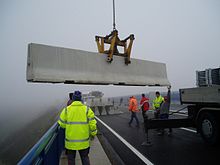Precast concrete manufacturer

The precast concrete manufacturer produces precast concrete elements from reinforced or prestressed concrete and carries out their assembly. The apprenticeship as a precast concrete manufacturer is officially recognized under the Vocational Training Act .
history
Precast concrete elements have been used in the construction industry since the early 20th century. After the Second World War , the need for precast concrete parts increased particularly sharply due to the many destroyed apartments and bridges. Initially, production without the use of machines was common; it was only with the development of industrial robots that many companies switched to this technology. As a result of this development, the need for workers with specialist knowledge of precast concrete also grew. The occupation of precast concrete parts maker is one of the recognized training occupations today.
tasks
The precast concrete manufacturer produces the formwork according to the construction drawing , then reinforces it according to statics and concretes the precast concrete element in the required quality. After the concrete has hardened , he removes the formwork and cleans the component. He can then store the component on the factory premises or load it for transport. On the construction site , the precast concrete manufacturer assembles the components professionally, ie in the correct position and with properly manufactured component connections. He also has to pay attention to the correct storage of components on the construction site, since prestressed concrete components are stored differently than components with slack reinforcement . If the assembly is possible without special specialist knowledge (e.g. when assembling filigree ceilings in a single-family house), this task can also be taken over by other skilled workers. The Precast Concrete Builder Training Ordinance names the following skills, knowledge and abilities (§ 4 Paragraph 2):
- Preparation and application of technical documents,
- Manufacture and installation of formwork and forms,
- Manufacture and installation of reinforcements and reinforcements,
- Manufacture and testing of concretes, facing concretes and mortar,
- Manufacture of precast concrete parts and concrete products,
- Stripping, treating, transporting and storing precast concrete parts and concrete products,
- Repairing precast concrete parts and concrete products,
- Design and treatment of surfaces,
- Installation of precast concrete parts and concrete products as well
- Manufacture of pre-stressed concrete parts.
Professional requirements
In addition to strength and physical endurance, technical understanding is also required (storage of precast concrete parts, post-treatment of the concrete, robot operation during production). Most of the time, people work in working groups, so teamwork is important. Since high demands are placed on the precast concrete parts in terms of dimensional accuracy and surface properties ( exposed concrete quality ), both clean and precise work are required.
Workplace
Precast concrete builders are employed by construction companies, concrete processing companies and all kinds of precast concrete plants. There they work in large halls or on the storage area, which is mostly on the open-air site. The assembly of the precast concrete elements takes place on the construction site. Transports by rail or water are less common.
Activities in the area of craft be exercised take stone manufacturer .
Tools
In addition to the common tools for building trades, the precast concrete manufacturer needs appropriate equipment for compacting the concrete. He uses wheel loaders or forklifts for transport on the factory premises, and the gantry crane for bulky parts . Trucks have prevailed for transport to the construction site. On the construction site itself, the precast concrete elements are usually brought to the right place by crane.
health
Apart from the general consequences of physically strenuous activity and the resulting symptoms (back and knee problems), the precast concrete manufacturer is not exposed to any increased health risks. To protect health, there are accident prevention regulations and personal protective equipment (PPE) is provided.
outlook
The importance of precast concrete parts will continue to exist in the future, and a further increase in demand can even be expected. This development is characterized by the high cost pressure in the construction industry and the constantly progressing rationalization of construction methods, including the use of precast concrete parts.
literature
- Batran, Bläsi, Eichner: Expertise in construction . 8th edition. Handwerk und Technik Verlag, 2002, ISBN 3-582-03503-4 .
Web links
- Ordinance on vocational training for precast concrete part builders (Precast Concrete Part Builder Training Ordinance - BetonFBAusbV) of 13 July 2015 ( Federal Law Gazette I p. 1179 )
- Announcement of the Precast Concrete Builder Training Ordinance and the framework curriculum from August 18, 2015 ( BAnz AT October 8 , 2015 B1 )
- Job description precast concrete manufacturer at the employment agency . Retrieved October 11, 2010.
- IHK Schwerin for vocational training in precast concrete construction . Retrieved October 11, 2010.
